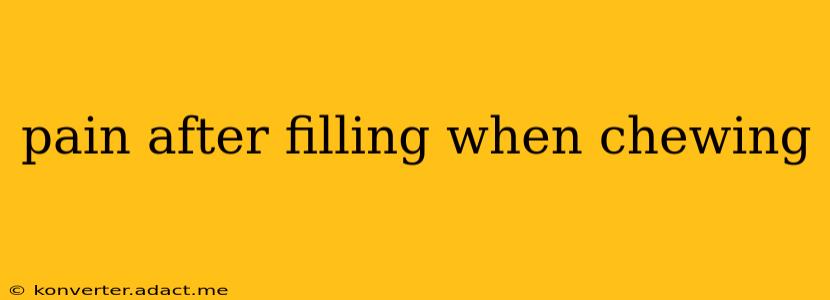Experiencing pain after a dental filling, especially when chewing, is a common concern. While it's often temporary and resolves on its own, persistent pain warrants attention. This comprehensive guide explores the potential causes, effective treatments, and preventative measures to alleviate discomfort and ensure long-term oral health.
What Causes Pain After a Filling When Chewing?
The pain you feel when chewing after a filling is often a sign that something isn't quite right. Several factors can contribute to this discomfort:
- Irritation of the tooth: The filling process itself can cause temporary irritation to the tooth's pulp (the soft tissue inside the tooth). This irritation can manifest as sensitivity to pressure, temperature, or chewing.
- High filling: If the filling is placed too high, it can interfere with your bite, creating pressure and pain when you chew. This is a common cause of post-filling discomfort.
- Infection or inflammation: In some cases, an infection or inflammation can develop around the filling, leading to persistent pain and discomfort.
- Cracked tooth: A pre-existing crack in the tooth may have been exacerbated during the filling procedure, leading to pain when chewing. This is more serious and needs immediate attention.
- Sinus infection: Pain in the upper back teeth can sometimes be referred pain from a sinus infection. This pain may worsen when chewing due to pressure changes in the sinuses.
- Bite misalignment: Changes in your bite due to the filling may result in pain. This can cause you to chew on one side more than the other, leading to jaw pain.
How Long Does Post-Filling Pain Usually Last?
The duration of pain after a filling varies. Mild discomfort typically subsides within a few days to a week. However, persistent or worsening pain requires a visit to your dentist. Don't hesitate to seek professional help if the pain is severe, doesn't improve, or is accompanied by other symptoms like swelling or fever.
What to Do if You Have Pain After a Filling When Chewing
If you're experiencing pain after a dental filling while chewing, here's what you should do:
- Over-the-counter pain relievers: Ibuprofen or acetaminophen can help manage mild to moderate pain. Follow the recommended dosage instructions.
- Gentle cleaning: Gently clean the area around the filling with a soft-bristled toothbrush and fluoride toothpaste. Avoid harsh scrubbing.
- Avoid hard or chewy foods: Stick to soft foods that don't put excessive pressure on the filling or the tooth.
- Contact your dentist: If the pain is severe, persistent, or worsens, schedule an appointment with your dentist immediately. They can assess the situation and determine the appropriate course of action.
Can a High Filling Cause Pain?
Yes, a high filling is a common cause of post-filling pain, particularly when chewing. The filling material may interfere with your bite, causing pressure and discomfort on the affected tooth. Your dentist can easily adjust the height of the filling to resolve this issue.
Is Pain After a Filling Normal?
Some mild discomfort is considered normal immediately after a filling. However, severe, persistent, or worsening pain is not. If you're experiencing significant pain or other symptoms, it's crucial to contact your dentist for evaluation.
How is Pain After a Filling Treated?
Treatment for post-filling pain depends on the underlying cause. It could involve:
- Adjusting the filling: If the filling is too high, your dentist will adjust it to restore proper bite alignment.
- Medication: Antibiotics may be prescribed if an infection is present.
- Root canal: In severe cases, a root canal may be necessary to address infection or inflammation within the tooth.
- Crown: A dental crown may be needed to protect a weakened tooth.
How to Prevent Pain After a Dental Filling
Following these steps can help reduce the risk of post-filling pain:
- Choose a qualified dentist: Select a dentist with experience and a good reputation.
- Communicate effectively: Let your dentist know about any pre-existing sensitivity or pain in the tooth before the procedure.
- Follow post-operative instructions: Adhere to your dentist's instructions regarding diet, oral hygiene, and pain management.
By understanding the potential causes and taking appropriate preventive measures, you can significantly reduce the chances of experiencing pain after a dental filling. Remember, timely intervention from your dentist is key to resolving any discomfort and ensuring the longevity of your dental work.
